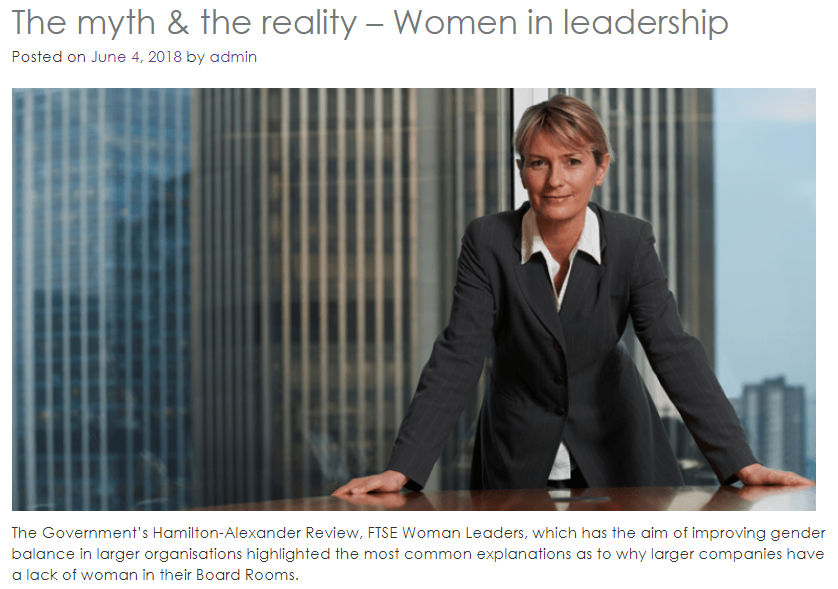A new report backs up previous research that although female No-executive directors are at an all-time high female executive positions have flatlined.
A report by Cranfield School of Management has criticised the lack of progress in improving gender diversity of the highest executive positions of FTSE 350 companies. Despite progress in female representation on non-executive board positions, the report identifies the lack of women in executive roles on boards of the UK’s leading companies.
A detailed analysis the data provided by the UK’s top 350 companies was scrutinised by experts from the school’s International Centre for Women Leaders. The Female FTSE Board Report’s authors identify the leading players in gender diversity, and highlight those companies that are lagging behind.
The report confirms “that there has been some progress over the last 20 years, and it’s encouraging to see the biggest companies in the UK on track to hit the 33% target. But that is still only 33%. The benefits of greater diversity are clear so now it’s up to the FTSE 250 to increase their ambition.”
The report’s analysis shows:
- FTSE 100 – while the percentage of female non-executive directors is at an all-time high of 35.4%, female executive positions have flat-lined for a fourth consecutive year at 9.7%. Despite this, the percentage of women on boards has increased from 27.7% in October 2017 to 29% in June 2018, meaning it may be possible to reach the target set by the Hampton-Alexander Review of 33% by the end of 2020.
- FTSE 250 – the number of female executive directorships dropped from 38 to 30 between October 2017 to June 2018. There has also only been a marginal increase in the number of women on boards, from 22.8% in October 2017 to 23.7% in June 2018 on the FTSE 250.
- FTSE 100 and the Gender Pay Gap – the top 10 companies for the proportion of women on boards, reported a slightly lower average gender pay gap than the bottom 10. The two best companies were Diageo (55% women on boards, 4.1% gender pay gap) and GlaxoSmithKline (45% women on boards, 2.8% gender pay gap)
- Female directors are on average nearly two years younger than their male counterparts, but serve for less time and have an average tenure of 3.7 years compared to 5.4 years for men.
Professor Sue Vinnicombe CBE, Professor of Women and Leadership at Cranfield School of Management, said: “Now, more than ever, is the time for disruptive change. We need to think big and act decisively in order to move the needle. FTSE 350 companies need to treat gender diversity as seriously as they treat sales, risk management and innovation, otherwise nothing will change.”

Sarah Morris, Chief People Officer, Aviva
Aviva has sponsored the Female FTSE Board Report since 2017. Sarah Morris, Chief People Officer, Aviva is also a non-executive director on the Aviva Investors Board. She said: “There has been some progress over the last 20 years, and it’s encouraging to see the biggest companies in the UK on track to hit the 33% target. But that is still only 33%. The benefits of greater diversity are clear so now it’s up to the FTSE 250 to increase their ambition. Still too little is being done to change the cultures which prevent talented women staying and rising to the top. We urge companies to act faster, for the sake of their people and their business.”
Professor Ruth Sealy, Director of Exeter Business School’s Centre for Leadership and co-author of the report, said: “The lack of diversity amongst executives of so many FTSE companies reveals such poor management. Organisations must now be bold and decisive in designing senior roles and careers fit for the 21st century in order to optimise the available talent”.
The study offers several recommendations to help boost the female executive talent pipeline. These include:
- Recognising the added value of functional heads on executive committees and considering them more seriously as an important pipeline of executive and non-executive board talent
- Recognising that men and women may express leadership aspirations in different ways to ensure that not only those that naturally ‘claim’ leadership roles are given the chance to step up
- Recognising the critical role sponsors, organisational cultures, and inclusive talent processes play in forming and affirming leaders.
Dr Elena Doldor, Senior Lecturer at Queen Mary University and Visiting Fellow at Cranfield School of Management, led the interviews. She said: “Leadership does not emerge in a vacuum. If companies are serious about developing the female executive pipeline, they should ensure that their organisation truly enables talented women to flourish as leaders.”

Read The Female FTSE Board Report 2018
You can read advo’s recent post about the Hamilton-Alexander Review here.
You can read the Aviva press release here.



